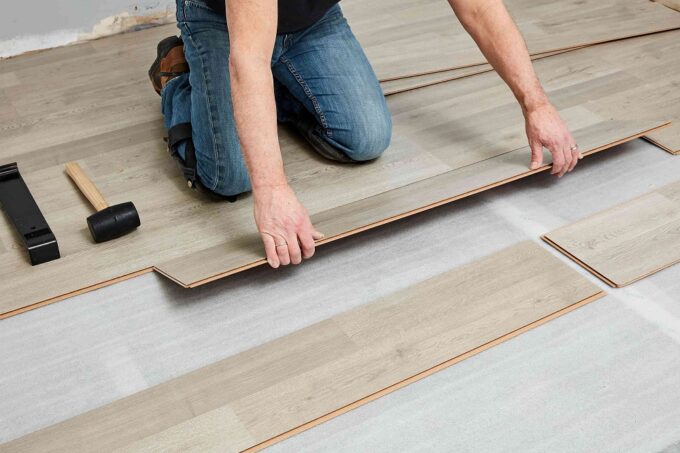Whether you recently bought a fixer-upper or just want to give your house a facelift, home renovations are pricey. A $2,000 project can quickly become a $10,000 project if you’re not careful.
Fortunately, taking the time to plan and budget can keep you from overspending on new floors or a bathroom sink. Check out the tips below to prevent your next home project from breaking the bank.
1. Know Your Financing Options

You used to meet with a personal loan officer if you wanted to remodel your family room. However, homeowners now have more options for financing home improvements, from home equity loans to cash-out refinancing. Many lenders are happy to create a loan unique to your situation. But before you apply for a loan, you’ll have to know how much money you need to borrow.
Lenders will be happy to provide financing once you’ve determined how much your renovation will cost, right? Not necessarily. If you have poor credit, you’ll likely receive a small loan with a high interest rate or no loan at all. To help improve your credit, start using a credit builder card. According to Due, simply opening a credit builder account can boost a low-credit consumer’s average credit score by about 30 points.
2. Don’t Do Everything All At Once
While it may be tempting to renovate your entire house in one go — launching kitchen, bathroom, and other projects simultaneously — this approach is costly. Most Americans spend an average of $15,000 on a single home remodeling project. If you multiply this by three or four, home renovation can become prohibitively expensive fast. This doesn’t even include the cost of living elsewhere while your home is under renovation.
Instead of diving headfirst into full-scale remodeling, prioritize which projects will have the biggest impact on your life. Let’s say you love cooking beautiful meals for your family and spend more time outdoors than in your basement. In that case, it would make sense to focus on a kitchen remodel before tackling a rec room renovation.
3. Get Bids From Multiple Contractors

Source: suncoastpermits.com
Even for a small home project, you want to ensure you get the best-quality work for a good price. That’s why it’s important to get bids from multiple contractors before deciding which one to use. This gives you the chance to compare prices, experience, and timelines. Aim to get three to five bids before moving forward with a contract. The best contractor for your project should stand out clearly from the pack.
When looking for a contractor, start by asking your friends and family whom they’ve worked with. Next, visit these contractors’ websites, such as applyrite.com.. Look for examples of projects they’ve completed, before and after photos, and customer reviews. If, after doing your research, you’d like to get a bid, send the contractor information about your home project.
4. Choose Less Costly Materials

Source: thespruce.com
While you may think you want granite countertops, materials like granite and quartz can quickly blow your budget. Taking the time to find lower-cost materials can save you a ton of money without sacrificing aesthetics.
One way to do this is by using recycled materials over new ones. This doesn’t mean your new kitchen will look like a salvage yard. With a little creativity, you can create a beautiful space and reduce your ecological footprint in the process.
Locating recycled items is pretty easy if you know where to look. For example, the Building Materials Reuse Association has an extensive directory of places selling recycled wood.
Reclaimed wood from barns and old buildings can be used for cabinets and floors, giving your home unique character. Other places to look for materials include scratch and dent stores and tear-down sites.
5. Give DIY a Try
Labor is expensive. Hiring people to tackle your kitchen makeover can increase the project cost by 30% to 35%. While some things like plumbing and electricity require the expertise of a trained professional, other projects don’t. Learning how to tile floors or paint walls can help you save some serious cheddar when it comes to home renovation.
But how do you know which projects you should tackle and which are better left to the professionals? Consider your safety first. If a project could cause physical harm, leave it to someone who can safely handle the danger. And if a DIY mistake like faulty wiring or a water leak could seriously damage your home, let a professional tackle it.
6. Sell What You’re Not Using

Source: rocketmortgage.com
The saying “One person’s trash is another person’s treasure” is especially true when it comes to remodeling. While you may hate your bathroom sink or bedroom ceiling fan, someone else may well love it. So, instead of throwing out items you’re no longer using, sell them to offset the cost of renovations.
Facebook Marketplace, eBay, and Craigslist are all great sites to sell used items. If online reselling isn’t your thing, having a garage sale is a low-hassle way to get rid of your old stuff. A scrap yard will happily give you money for any leftover metal items that don’t sell.
Tackling a home renovation project isn’t cheap. However, there are steps you can take to make the process more affordable. By following the tips provided above, you can create the house of your dreams without overspending.







